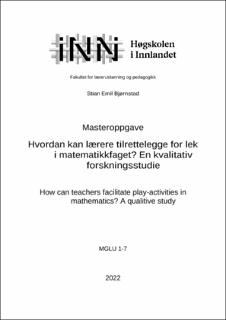Hvordan kan lærere tilrettelegge for lek i matematikkfaget? En kvalitiv forskningsstudie
Master thesis
Permanent lenke
https://hdl.handle.net/11250/3019790Utgivelsesdato
2022Metadata
Vis full innførselSamlinger
Sammendrag
Denne oppgaven har som formål å bistå til forskningen på tilretteleggingen av lek innenfor matematikkfaget. I lys av LK20 sine nye kompetansemål om læring gjennom lek og mer frihet til å arbeide med stoffet grundigere vil denne oppgaven derfor fokusere på hvordan en lærer kan tilrettelegge undervisningen sin for å få integrert leken. Gjennom en kvalitativ undersøkelse har jeg utført en undersøkelse der hovedtemaene har gått ut på å finne svar på hvordan lærere bruker leken i sin undervisning, hvilke ressurser som er nødvendige for å anvende leken og hvilke fordeler og ulemper det er ved å bruke lek i matematikkundervisningen. Jeg har også anvendt teori til å finne lærerens rolle i å fremme læringen gjennom leken.Sentrale funn jeg har uthentet fra empiri og teori er at konkretiseringen av matematikken er det viktigste innen begynneropplæringen for å danne en forståelse for matematikkfaget og at denne konkretiseringen finner sted i lek og aktiviteter. Samtidig så er leken veldig ressurskrevende i forhold til materialet som trengs, plassen du har tilgjengelig og hvor mange voksne ressurser som er til stede i undervisningen. Når det gjelder fordelene og ulempene har jeg funnet resultater som hovedsakelig involverer motivasjon og interesse hos elevene som en stor fordel og krevende gjennomføring og forberedelse av leken i forkant av undervisningen er en stor ulempe. Lærerens jobb er å sørge for trygge rammer for elevene samtidig som at de skaper en matematisk tankegang gjennom rike og ledende spørsmål. This thesis has as purpose to assist further research on the facilitation of play-activities within the mathematic school subject. Considering LK20’s new competence goals about learning through play-activities and more freedom to work with the subjects more thoroughly will this thesis focus on how the teacher can facilitate their tuition to integrate more play-activities. Through qualitative research has I conducted research with a few primary themes that has been used to find answers to how teachers use play-activities in their classes, what resources are needed to perform said play-activities and which pros and cons there is to using play-activities as a learning platform. I have also used theory to discuss what part of the play-activities that teachers take on during these activities.Some of the most important findings of my research was that the concretization was the most important for beginner training within mathematics to develop an understanding of mathematics and that the concretization appears more often through play-activities. I also discovered how resource-demanding learning through play-activities are, all within materialistic resources, space and numbers of needed adults. I did find out that the most important pro was the motivation and interest for math grows within the pupils during the play-activities and for the cons that the planning and execution of the planned play-activities are very demanding of the teacher. The teacher’s job is also to ensure that the pupils feel safe while partaking in the play-activities while helping develop a mathematic thought process through rich and leading questioning.
